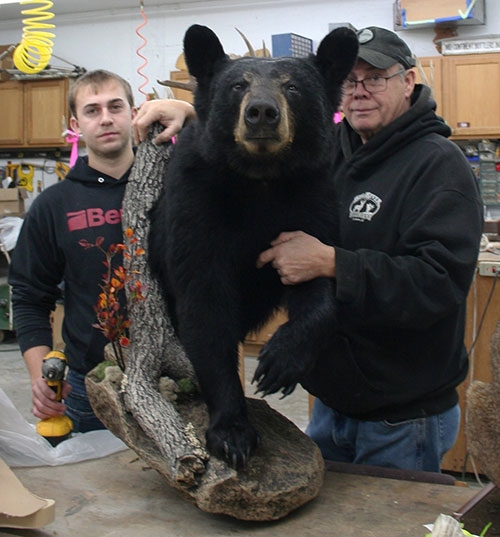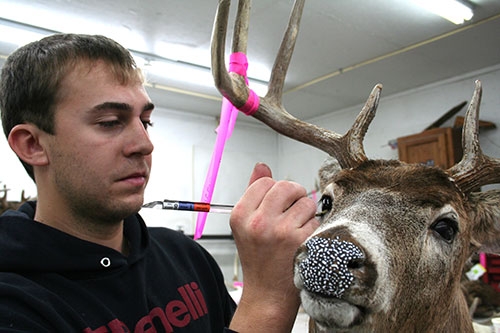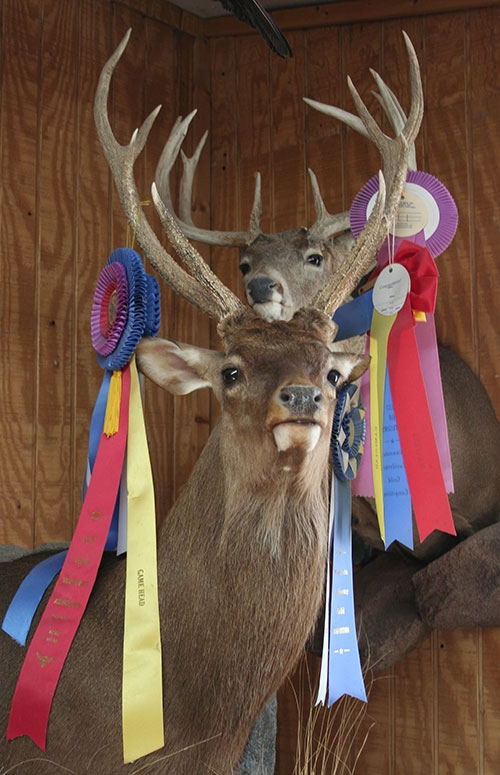You are here
Home ›Master taxidermist Jeff Morris is sharing the knowledge and expertise of his decades-long career with young business-partner-in-training, Gabe McCann

Productive partnership ... Gabe McCann and Jeff Morris (left to right) are attaching the habitat to a recently completed Black Bear mount at Big River Taxidermy in Lansing. Over the past few years, McCann has been learning the art of taxidermy from Morris. Photo by Julie Berg-Raymond.

A keen eye for detail ... Gabe McCann is rebuilding the eyelids and nose pad on a whitetail deer. The white dots on the nose pad are Mod Podge - the brand name of a glue, sealer and varnish in one, used for decoupage and other arts and crafts. This is a first step in rebuilding the nose pad; the Mod Podge will be translucent when it dries. Photo by Julie Berg-Raymond.

Racking up the awards... This whitetail head crafted by Jeff Morris of Big River Taxidermy won three state champion awards at the Master’s level, as indicated by the many ribbons hanging from its antlers. Morris has stepped away from the competition aspect of taxidermy in recent years, wanting to more fully concentrate on the work that he does for his customers. Photo by Julie Berg-Raymond.
by Julie Berg-Raymond
Master taxidermist and owner of Big River Taxidermy in Lansing, Jeff Morris is, after almost three decades, turning over part of the widely renowned business to a young man who has been working with Morris as his apprentice for five years - Gabe McCann, of Gays Mills, WI.
“Big River Taxidermy is still what it has always been,” Morris says. “I’m still going to take care of my long-term customers - and I’ll continue to take on some new ones. I’m just handing over a portion of the business to Gabe, and he’ll be working under my supervision.”
Even in the “sportsmen’s paradise” that is the Upper Mississippi River Valley, not everyone has had occasion to seek the services of a professional taxidermist. But anyone who has ever visited the Driftless Area Education and Visitor Center or eaten at Red Barn Resort in Lansing - or had a beer at Toppling Goliath Brewing Co. in Decorah - has seen Morris’ work. That work has long been in high demand, as the multiple award-winning taxidermist’s reputation has grown over the past two-plus decades.
ABOUT TAXIDERMY
“Taxidermy understood as an ornamental art or as a technique for study purposes dates back to over four centuries ago,” writes Caroline Galambosova, in “From Specimen to Contemporary Taxidermy” (Daily Art. Nov., 2021). Taxidermy is not a process of “stuffing”; instead, it is a process of “mounting,” sewing and fixing the skin onto a form. (The word “taxidermy” comes from ancient Greek - a combination of two separate words: taxis (arrangement, disposition) and derma (skin).)
“What sets taxidermy apart as an art is that the medium is intrinsically linked with nature,” according to Eva Amsen, writing for Forbes Magazine in October, 2019 (“Is Taxidermy an Art or a Science?”). “Unlike other art forms, which may occasionally be inspired by science, taxidermy requires an understanding of the natural world. Some basic anatomy knowledge is essential to create taxidermy art.”
But a taxidermist also needs “a very artistic eye and hand,” Morris says. Knowledge of anatomy and an understanding of the natural world meet the art of taxidermy in what he describes as an ability to “‘read the reference’ - to be able to recreate the reference shape and color. You have to be able to interpret and re-create off of whatever you have,” he says. The reference could be a photograph, a cast or “the real, live animal.” For 20 years, Morris kept live deer at the rural Lansing home he shares with his wife, Wendy. “I studied them all the time,” he says.
ABOUT THE TAXIDERMIST
Originally from Waterloo, Morris grew up loving to hunt and fish with his dad. “We’d come up here to the Lansing area,” he recalls. “That’s when I fell in love with the area.”
He started experimenting with taxidermy as a child, when his great-aunt Mary - who also did some taxidermy, mostly with smaller birds - gave him a lesson booklet from the Northwestern School of Taxidermy. “That was the go-to education for aspiring taxidermists in the ‘60s and ‘70s,” Morris says.
As he got older, Morris found two mentors who helped him refine his knowledge and skills - one, who lived in his neighborhood, taught him about mounting deer and eventually sold Morris his tools and equipment. Later, he took private lessons from the late Gary Bowen, one of the leading whitetail taxidermists in the world. But the bulk of his learning, Morris says, came when he started competing in the early ‘90s.
“The piece that you enter gets critiqued, and the judge tells you how to make it better,” he says. Additionally, competitions feature seminars and workshops at which competitors can further develop their skills and expertise.
Morris opened Big River Taxidermy in downtown Lansing in 1997. By the early 2000s he had moved from the Professional Division into the Master’s Division on the competition circuit (he never competed in the Amateur Division). Ultimately a seven-time state champion in several states with deer heads and game heads, Morris competed in Iowa, Minnesota, Wisconsin, South Dakota and at the World Taxidermy Competitions - earning, along the way, a regional and then national reputation for his work and for Big River Taxidermy.
By the late 2000s, Morris had become a whitetail judge, himself, for five different state shows. In 2008, he moved the Big River Taxidermy studio to his and Wendy’s home in the country. Morris “stepped away from competition” around 2012, he says, “to better serve my customers. I might spend 100 hours on one head for a show” - which was, of course, time taken away from his professional work.
ABOUT THE APPRENTICE
Around five years ago, with the possibility of retirement starting to peek over the horizon, Morris decided to take on an apprentice. He’d long been teaching classes in whitetail taxidermy; but now he was interested in working with someone who could join him in the business and, one day, take it over.
Enter Gabe McCann - at the time a high school senior in Gays Mills, WI. His family had been Morris’ customers for over 20 years, so they already knew each other. McCann and his dad started talking about working with Morris and learning taxidermy, “and I just thought it would be cool to do the work and see how it’s done,” he says. “I’m into hunting a lot, and fishing. I’ve been an ‘outdoorsman’ my whole life.” McCann started doing school-to-work at the taxidermy studio with Morris, driving over to Lansing after classes.
For the first couple of months, McCann recalls, he just watched how Morris worked. “We took our time,” he says. “He taught me a lot.” McCann gradually took on more tasks, putting to work what he was learning, and he continued “watching, for months on end.” About two years ago, McCann did his own first mount. Three years later, Morris says working with McCann is “awesome … He’s not an apprentice anymore; he’s earned his badge. He’ll still be working under my supervision, though.”
The two men work together, now - with McCann sometimes stepping in on a piece where Morris has left off, and vice versa. Their process, generally speaking, works like this: 1) A customer brings in a “specimen”; 2) the specimen is skinned in the studio/shop; 3) it is sent to the tannery in New Hartford; 4) it comes back from the tannery, and goes into the freezer until they’re ready to work with it; 5) it’s taken from the freezer, washed with soap and water, and spun dry; 6) Clay work is done - this is the step where much of the artistic work comes in: They sculpt the muscles, eye sockets and ear butts/bases out of clay onto a foam mannequin that approximates the animal whose skin they have; 7) they pull the skin over the mannequin, sew it up, and let it dry. The final work involves painting and finishing - another step where artistry is all-important. “It’s all about the details,” Morris says.
McCann says he enjoys everything about the work he’s doing at Big River Taxidermy - including, he says, “seeing different types of deer come in the door and talking with customers.” As for any advice he might offer another young person interested in learning taxidermy: “It’s a hard thing to get into,” he says. “It’s something that you have to really want to do.” The most important thing, he says, is to go into it with the right attitude. “It’s something that takes time. You have to be patient with your work and be sure that everything is done right.”
Big River Taxidermy is located at 1788 South Road Drive, Lansing. For more information, call 563-538-3840 (shop) or 563-568-1748 (cell); e-mail bigriverjeff@yahoo.com or visit the website at bigriver.qwestoffice.net.

